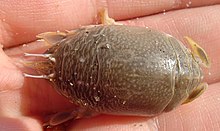Emerita (genus)
| Emerita | |
|---|---|
 |
|
| Female Emerita analoga | |
| Scientific classification | |
| Kingdom: | Animalia |
| Phylum: | Arthropoda |
| Subphylum: | Crustacea |
| Class: | Malacostraca |
| Order: | Decapoda |
| Family: | Hippidae |
| Genus: |
Emerita Scopoli, 1777 |
| Type species | |
|
Cancer emeritus Linnaeus, 1767 |
|
| External identifiers for Emerita | |
|---|---|
| Encyclopedia of Life | 44087 |
| ITIS | 98132 |
| NCBI | 41005 |
| WoRMS | 158392 |
| Also found in: | |
Emerita is a small genus of decapod crustaceans, known as mole crabs, sand fleas, sand crabs, sand fiddlers or sea cicada. These small animals burrow in the sand in the swash zone and use their antennae for filter feeding.
Emerita has a barrel-shaped body. It has a tough exoskeleton and can hold its appendages close to the body, allowing it to roll in the tidal currents and waves. It has feathery antennae, which are used to filter plankton and detritus from the swash.
Males are typically smaller than females, and in some species, such as Emerita rathbunae, the minute males live attached to the legs of the female. Females are around 8–37 mm (0.31–1.46 in) in carapace length, depending on the species, while males vary from a similar size to females in E. austroafricana, down to 2.5 mm (0.098 in) carapace length in E. rathbunae and E. talpoida.
The genus as a whole has a broad distribution in tropical and subtropical regions. Most individual species, however, are restricted to smaller areas, and their ranges rarely overlap. The genus is common on both coasts of the United States and along the Atlantic coast of Africa; the related genus Hippa is found across the Indo-Pacific, including Australia.
Ten species are recognised as of 2010[update]:
The Old World species had been widely thought to form a monophyletic group, as did the New World species. The use of molecular phylogenetics has shown, however, that E. analoga, a species living along the Pacific coast of North America, is more closely related to African species than it is to other New World species.
...
Wikipedia
